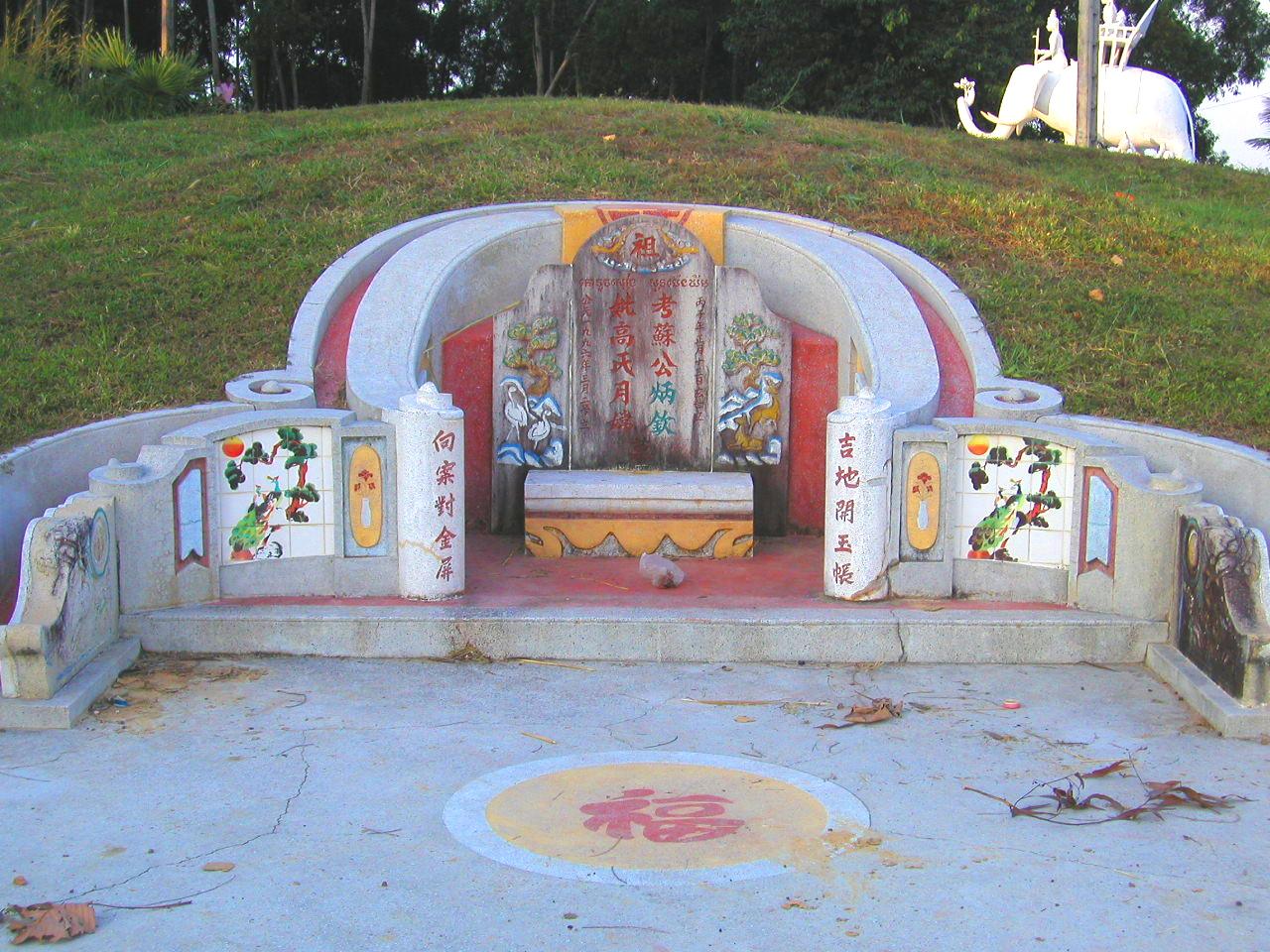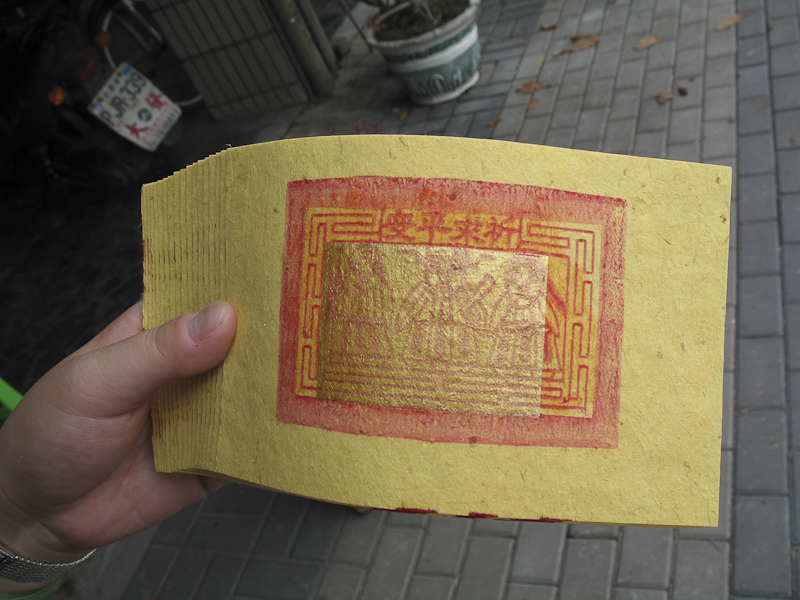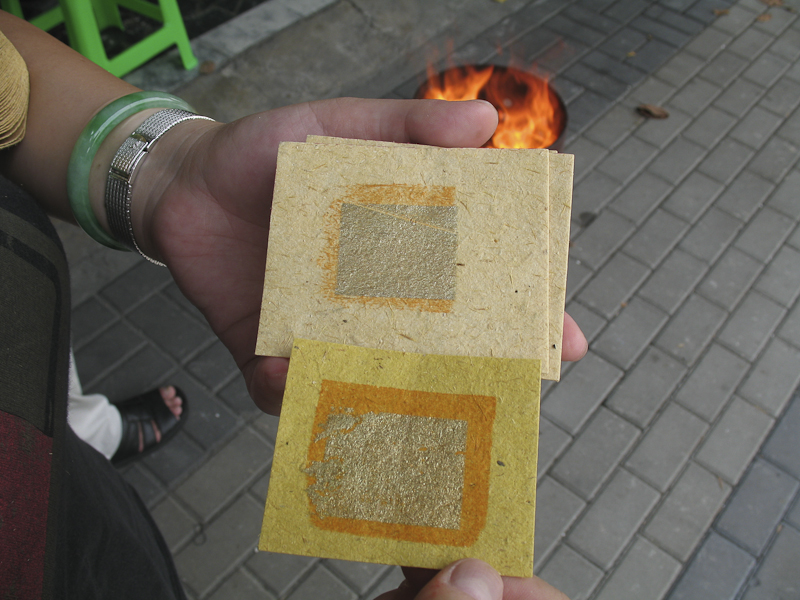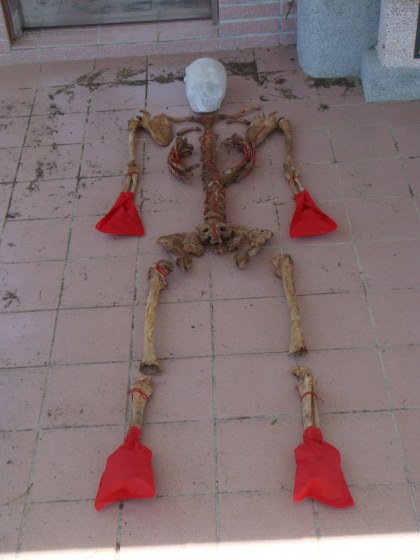April 5th is celebrated as Memorial Day here in Taiwan. In America, Memorial Day is a day for remembering soldiers, especially those who have given their lives in service. In Taiwan, however, Memorial Day is a day of remembrance for every member of your family that has passed away. It is very closely tied to Buddhism and, as this was my first Taiwanese Memorial Day, I’ll try to give an accurate representation of events.
Miss Expatriate’s family lives in Kaohsiung but we needed to travel to Beigang (approximately 90 minutes away) as that is where her family members have been interred. Actually, they don’t have graves proper. Rather, they have been incinerated, placed in urns, and then placed in a small locker at this temple in Beigang. This is pretty common for many families in Taiwan.
There are Chinese graves. They are very elaborate and very large and usually look like this:

They are also very expensive, as one must buy the tomb, pay rent for the land, and then clean it off and take care of it every year on Memorial Day. As such, most people have their loved ones cremated and placed in the lockers inside the temple.
But graves like these are more or less what I saw when we arrived. There are many rows of graves and then many lockers inside the temple. Unfortunately, I didn’t have my camera along. I’ll try to get some pictures next time.
Because it was Memorial Day, there were quite a few people there. There are many tables set up in front of the temple where people place offerings of fruit and then burn incense and pray. They then either go to the grave of their relatives and pray and burn more incense or go inside to the lockers and do it.
Miss Expatriate’s family has 6 family members in adjacent lockers inside the temple and has their pictures on them for identification. Her grandparents, great grandparents, and great-great grandparents (all from father’s side).
Once they finished praying and burning incense, it was time to take the gold money and burn it in offering. Gold money is a huge industry for Buddhism. They take a yellow piece of paper, occasionally put some fancy designs on it, and then place a thin leaf of gold on each one. These are burned in offering so that the deceased will have money to spend in the afterlife. They often look like this:


While walking over to the area where they burn the ghost money, I noticed several of the graves had been opened. It was a little shocking, as it literally looked like someone had taken a shovel and looted the corpses in the middle of the night. Piles of freshly dug earth were laying around and there was even a shoe laying on one. I briefly wondered whether someone had been buried with that shoe and it had now fallen off and been left on the side of the grave.
My morbid curiosity even got the better of me and I got quite close and leaned over to look in. Fortunately, nothing was there, but you could easily tell it had recently been exhumed. Miss Expatriate explained that it was all quite normal. The graves are cleaned every year and, after 10 years or 20 years, the bodies are exhumed, cleaned, and either reburied or cremated and placed in a locker at the temple. It’s an interesting system.
Anyway, we walked over and Miss Expatriate, her cousin (the oldest grandson of the family) and her father burned the ghost money in the designated place. It was only them as only the sons of the family take care of the deceased. After a woman is married, she will “give up” her family. She will no longer pray for her ancestors or visit their tombs. Certainly, they keep in touch with their living family members, but they lose their ancestors and acquire those of their husbands.
We then gathered the fruit we had previously left and prepared to go. We went behind the temple to use the restroom first and, upon coming out, I noticed an older man sitting on the ground sanding and brushing some pieces of wood. Or, at least, that’s what I thought they were.
They looked vaguely like rough pieces of dark wood and he had a small brush (much like Archaeologists use) and was brushing the dust off. Rather odd, I thought to myself, to be brushing off these odd-shaped pieces of wood and I stood for a few seconds pondering it, as it just wasn’t sitting quite right with me but I couldn’t place my finger on it…
Then Miss Expatriates father said, quite matter-of-factly as he lit up a cigarette, “Bones.”
Ah yes…. I recognized it as a femur. There’s the skull, missing the lower jaw. That appears to be an arm and maybe a hand. What Miss Expatriate had previously explained about the bodies being exhumed and cleaned after 10 or 20 years was now right in front of me.
It was really quite surreal for me, as we don’t normally do that thing in America, nor are we ever really exposed to it unless you happen to work in the funeral industry. In Taiwan, however, and in the Buddhist culture, it’s all quite normal. It is part of Memorial Day, after all. The man, it turns out, works for the temple and a family had hired him to take the bones of their loved one, clean them off, and then arrange them on a white sheet for inspection before they were sent off to be cremated and the ashes stored in the temple. Everyone around obviously thought nothing at all of this gentleman smoking a cigarette and brushing years of dirt and mildew off these browned bones that someone had hired him to clean. I wish I would have taken a picture, but again, no camera and it probably have been quite disrespectful.
Miss Expatriate did, however, find these photos on the internet. They look similar and are pictures of the bones after they have been cleaned off and arranged. Some of you with weaker stomachs may not like to look at this.

After that, we drove back and enjoyed a really nice Memorial Day meal. Ever year, Miss Expatriate’s mother makes Spring Rolls to celebrate Memorial Day. They were really quite delicious.
Leave a Reply